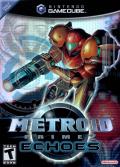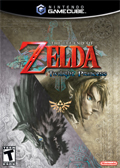
Published by Nintendo, Developed by Retro Studios
Genres: Action / Adventure (4 players)
US release date: Nov 15th, 2004 | EU release date: Nov 26th, 2004
Not as good as the first, but still darned good.
Review written by
Andrew Gray
Although this review probably will not show up until the Metroid Prime 3: Corruption hype is well underway, I still thought it would be a good idea to help remind players why Metroid still continues to be great. Although Prime 2 isn't as good as the original (which is odd, but I chalk it up to experimentation) it still sparkles with some of that pure Nintendo magic.
Light and Dark worlds...
Prime 2's setting marks quite a drastic change from the original. In part 2, Samus is called in by the galactic Federation to investigate a missing troop deployment sent to the planet Aether who were in turn sent because of a growing Space Pirate presence. The Pirates were initially drawn to the world by the fact that it was another world which possessed the powerful substance of Phazon, but these elements take a backseat compared to how they were presented in the first game.
Instead, Samus stumbles across an ancient conflict involving two races which both embody the forces of light and dark, learning that Aether has literally been split into two dimensions due to Phazon. As if that weren't enough, Metroid Prime itself has followed Samus in the form of 'Dark' Samus. Dark Samus, while identical to the woman in form, is much faster and stronger due to its constant draw on Phazon and shows up often to try and hinder your progress. The creature's presence however, seems more of a setup for Prime 3 than anything, with the game's focus on your efforts to heal what Phazon has wrought on Aether.
This split between Light and Dark worlds gives an interesting, yet mixed new play mechanic. On the one hand, in some cases the parallel world idea is very innovative, and those of us who have played Zelda: A Link to the Past know the kind of potential it has. Unfortunately, this idea is rarely used to its fullest potential and often is more challenging than it needs to be, due to the fact that the air in the Dark World is almost always poisonous to Samus; normal environments look amazing in a 'dark' setting, but without a quick environment change such as in ALTTP, travel in the Dark World can constantly be frustrating and overly difficult. To be honest, it isn't quite as bad as I'm making it sound if you know what you're doing, but oftentimes you'll probably need an FAQ.
Ammo in a Metroid game? You're kidding, right?
For the most part, Prime 2 retains the original's mechanics. Samus starts off weak, gradually getting stronger and gaining access to more areas with every power-up and upgrade available. Unfortunately, there were two things that Retro did wrong. The first is that they still encourage you to get a series of keys in order to open the doors to bosses, which you shouldn't need in a Metroid title. The second was the inclusion of ammo with the new Dark and Light beams; the whole point of Metroid is exploration, not hoarding ammo like in a FPS!
These are fairly minor complaints mind you, otherwise the gameplay is still stellar. Most powerups are similar to other Metroid games: Missile Launcher, Morph Ball, Space Jump, etc. There are two notable exceptions however; the Sound visor allows you to home in on sonic vibrations of an enemy otherwise invisible and replaces the heat visor, and players finally see the return of the classic Screw Attack. Admittedly, Prime 2's version isn't as great simply because it's a different sort of play experience, but the Screw Attack is still fun. In addition, the Varia and Gravity suits (and the Phazon suit) have been replaced by the Dark and Light suits, which admittedly look very very cool. It's still Metroid and it's still fun.
Space... The Final Frontier
So how is Aether itself? Honestly Tallon IV wins over the Luminoth world, but just barely. Aether's environment is suitably darker in tone than Tallon IV was, possessing a desert, a swamp, a marvelous technological city and a temple in the very sky itself. While these aren't quite as colorful as the environments on Tallon IV, but they do give Prime 2 an edge which its predecessor lacks. This is added on to by the bosses, which while not as original as the first game's, are some of the toughest little buggers you'll find in any game, hands down.
The amazing music in Prime is actually far better in Prime 2. More chanting is used, and the melodies change from the more rock/techno hybrid that Prime was to hauntingly beautiful processions which suit the mood of every new area you come across.
A Grand Experiment
Metroid Prime 2 was clearly an experiment, deviating quite a lot from the original Prime but also keeping to it in many ways. In some ways the experiment was a success, as Prime 2 proves that Nintendo games CAN stray from their basic stories and still be great. On the other hand, Retro needs to rethink the whole Light/Dark mechanic as well as abolish the stupid keys! That aside, Prime 2 is still one of Gamecube's best and one that if you haven't played, is one title you should definitely give a try.
Gameplay: 
Graphics: 
Sound: 
Lifespan: 
| Yes |
| No |
| Maybe |
 Shrek Smash and Crash
Shrek Smash and Crash
Activision
 The Legend of Zelda: Twilight Princess
The Legend of Zelda: Twilight Princess
Nintendo
Released on November 26th, 2006
 Flushed Away
Flushed Away
D3
Released on November 24th, 2006
spleefian said:
acting like this is even active at all but i just really dislike it sideways because to me it just looks incomplete ...
spleefian said:
seeing literally just "1 decade ago" is scary to me like id be used to it saying you know 12 or 13 years ago but just ...
spleefian said:
i wish i couldve been here during this sites heyday ...
grummyofficial said:
Experience the finest Aviator Game and take advantage of the helpful guides to win. visit aviatorgaming.info ...
gw117 said:
The download link doesn't work... ...
Wii's World is not officially affiliated with Nintendo! (but they wish we were).
User comments
No posts yet for this game. Be a pioneer.